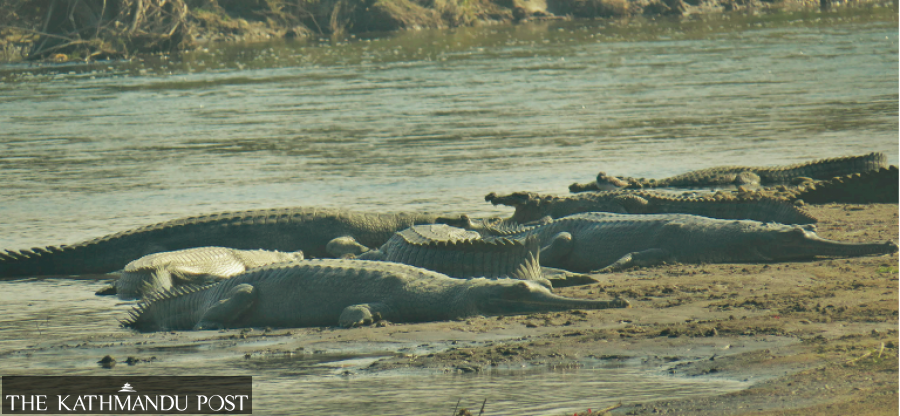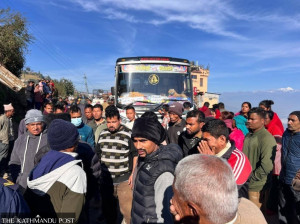Bagmati Province
Natural breeding of gharials seen at Dudhaura along Rapti river
The natural breeding of the critically endangered crocodile species is a good sign for gharial conservation in the country, conservationists say.
Ramesh Kumar Paudel
Conservationists and nature lovers are elated to see the breeding of gharials—a critically endangered crocodile species—in their natural habitat at the Dudhaura area along the Rapti river that passes through Chitwan National Park.
“There are around 100 baby gharials in the Dudharua area now. Some eggs are yet to be hatched,” said Prakash Bahadur Basnet, a resident of Sauraha, Chitwan. Basnet, who is also a field assistant to researchers Phoebe Griffith and Ranjana Bhatta, has been closely studying gharial breeding and habitat in the Narayani and Rapti rivers for the past three years. According to him, nearly 180 gharials were bred naturally in the area last year.
Gharials are found in some rivers of Nepal, India and Bangladesh, says Baburam Lamichhane, chief at the Sauraha Office of National Trust for Nature Conservation.
The Rapti and Narayani rivers are the natural habitats of the crocodile species.
The gharial population, which was estimated to be between 5,000 and 10,000 worldwide during the 1940s, declined by almost 96 percent to below 200 in 1976.
This species—the only surviving member of the Gavialidae family—breeds only in the wilds of Nepal and India and occupies only two percent (less than 200 mature breeding adults in number) of its historical range at present. The gharials have already gone extinct from Myanmar, Pakistan and Bhutan.
The natural breeding of gharials in the Dudhaura area of the Rapti river is a good sign for gharial conservation in the country, say conservationists.
“It is amazing to hear gharials making their nests and hatching babies in the Rapti river. Gharials were not found in the river until a few years back,” said Ramprita Yadav, the former chief conservation officer at the national park.
In 1978, the Chitwan National Park established a gharial breeding centre in Kasara with an objective to conserve the crocodile species by hatching its eggs and releasing them in the rivers when they grow up to two metres in length.
“A total of 1,515 gharials that grew up in the breeding centre have been released in various rivers as of now,” said Lokendra Adhikari, the information officer at the park.
However, the survival rate of those released gharials is not good. According to Lamichhane, the chief at the Sauraha Office of National Trust for Nature Conservation, 118 gharials were found in the Rapti river while 101 others were recovered from the Narayani river during the survey of the office last year.
Gharials are swept away by river currents, mainly by floods in the rainy season, and this makes their conservation all the more challenging, he said. Monsoon floods sweep away many gharials to India every year.
“Dudhaura area, where the gharials have been hatching eggs, is far from the Narayani river and the water flow there is not strong. The chances of gharials being swept away from the area are less,” said Lamichhane. “We are hopeful for the conservation of the species.”
The gharial has been enlisted as a protected species in Nepal. Conservationists say amid multiple challenges in gharial conservation, a threat to their habitat due to human activities, river pollution and depletion in fish numbers is the most worrisome.
The use of fishing nets that might trap gharials is another challenge in gharial conservation in Nepal. The Chitwan park has banned the use of fishing nets in rivers that are home to endangered species.
Meanwhile, the presence of gharials in the Rapti river has excited tourism entrepreneurs and workers. According to them, it will be very helpful to promote tourism in Chitwan.
“Tourists, mainly foreigners, will visit the Dudhaura area to look at gharials,” said Basanta Chaudhary, a Sauraha-based nature guide.




 11.12°C Kathmandu
11.12°C Kathmandu1.jpg)











